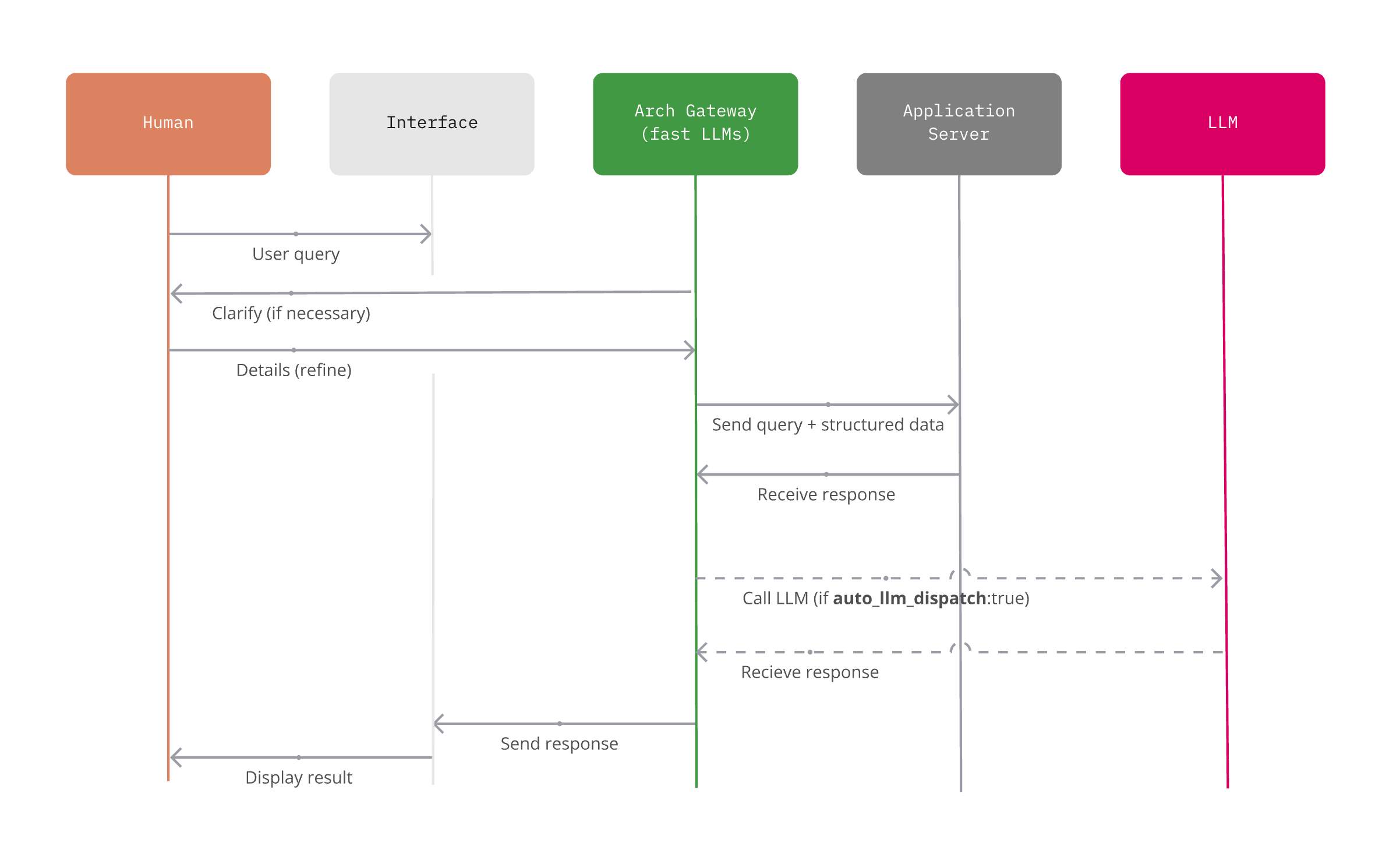Intro to Arch
AI demos are easy to build. But past the thrill of a quick hack, you are left building, maintaining and scaling low-level plumbing code for agents that slows down AI innovation. For example:
You want to build specialized agents, but get stuck writing routing and handoff code.
You bogged down with prompt engineering work to clarify user intent and validate inputs.
You want to quickly and safely use new LLMs but get stuck writing integration code.
You waste cycles writing and maintaining observability code, when it can be transparent.
You want to apply guardrails, but have to write custom code for each prompt and LLM.
Arch is designed to solve these problems by providing a unified, out-of-process architecture that integrates with your existing application stack, enabling you to focus on building high-level features rather than plumbing — all without locking you into a framework.

High-level network flow of where Arch Gateway sits in your agentic stack. Designed for both ingress and egress prompt traffic.
Arch is a smart edge and AI gateway for AI-native apps - built by the contributors of Envoy Proxy with the belief that:
Prompts are nuanced and opaque user requests, which require the same capabilities as traditional HTTP requests including secure handling, intelligent routing, robust observability, and integration with backend (API) systems for personalization - all outside business logic.
In practice, achieving the above goal is incredibly difficult. Arch attempts to do so by providing the following high level features:
Out-of-process architecture, built on Envoy: Arch takes a dependency on Envoy and is a self-contained process that is designed to run alongside your application servers. Arch uses Envoy’s HTTP connection management subsystem, HTTP L7 filtering and telemetry capabilities to extend the functionality exclusively for prompts and LLMs. This gives Arch several advantages:
Arch builds on Envoy’s proven success. Envoy is used at massive scale by the leading technology companies of our time including AirBnB, Dropbox, Google, Reddit, Stripe, etc. Its battle tested and scales linearly with usage and enables developers to focus on what really matters: application features and business logic.
Arch works with any application language. A single Arch deployment can act as gateway for AI applications written in Python, Java, C++, Go, Php, etc.
Arch can be deployed and upgraded quickly across your infrastructure transparently without the horrid pain of deploying library upgrades in your applications.
Engineered with Fast Task-Specific LLMs (TLMs): Arch is engineered with specialized LLMs that are designed for the fast, cost-effective and accurate handling of prompts. These LLMs are designed to be best-in-class for critical tasks like:
Function Calling: Arch helps you easily personalize your applications by enabling calls to application-specific (API) operations via user prompts. This involves any predefined functions or APIs you want to expose to users to perform tasks, gather information, or manipulate data. With function calling, you have flexibility to support “agentic” experiences tailored to specific use cases - from updating insurance claims to creating ad campaigns - via prompts. Arch analyzes prompts, extracts critical information from prompts, engages in lightweight conversation to gather any missing parameters and makes API calls so that you can focus on writing business logic. For more details, read Function Calling.
Prompt Guard: Arch helps you improve the safety of your application by applying prompt guardrails in a centralized way for better governance hygiene. With prompt guardrails you can prevent
jailbreak attemptspresent in user’s prompts without having to write a single line of code. To learn more about how to configure guardrails available in Arch, read Prompt Guard.
Traffic Management: Arch offers several capabilities for LLM calls originating from your applications, including smart retries on errors from upstream LLMs, and automatic cut-over to other LLMs configured in Arch for continuous availability and disaster recovery scenarios. Arch extends Envoy’s cluster subsystem to manage upstream connections to LLMs so that you can build resilient AI applications.
Front/edge Gateway: There is substantial benefit in using the same software at the edge (observability, traffic shaping algorithms, applying guardrails, etc.) as for outbound LLM inference use cases. Arch has the feature set that makes it exceptionally well suited as an edge gateway for AI applications. This includes TLS termination, applying guardrail early in the process, intelligent parameter gathering from prompts, and prompt-based routing to backend APIs.
Best-In Class Monitoring: Arch offers several monitoring metrics that help you understand three critical aspects of your application: latency, token usage, and error rates by an upstream LLM provider. Latency measures the speed at which your application is responding to users, which includes metrics like time to first token (TFT), time per output token (TOT) metrics, and the total latency as perceived by users.
End-to-End Tracing: Arch propagates trace context using the W3C Trace Context standard, specifically through the traceparent header.
This allows each component in the system to record its part of the request flow, enabling end-to-end tracing across the entire application.
By using OpenTelemetry, Arch ensures that developers can capture this trace data consistently and in a format compatible with various observability tools.
For more details, read Tracing.